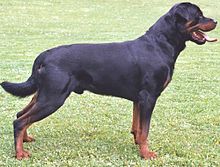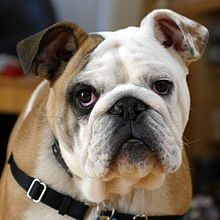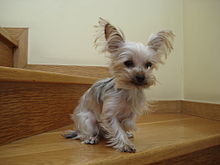Αppearance
 A small dog with a short muzzle and large, dark eyes. With a soft and A long double coat, the Shih Tzu stands no more than 26.7 cm (101⁄2 in.) at the withers and with an ideal weight of 4.5 to 7.3 kg (10 to 16 lbs). Drop ears are covered with long fur, and the heavily furred tail is carried curled over the back. The coat may be of any color, although a blaze of white on the forehead and tail-tip is frequently seen. The Shih Tzu is slightly longer than tall, and dogs ideally should carry themselves "with distinctly arrogant carriage." A very noticeable feature is the underbite, which is required in the breed standard.
A small dog with a short muzzle and large, dark eyes. With a soft and A long double coat, the Shih Tzu stands no more than 26.7 cm (101⁄2 in.) at the withers and with an ideal weight of 4.5 to 7.3 kg (10 to 16 lbs). Drop ears are covered with long fur, and the heavily furred tail is carried curled over the back. The coat may be of any color, although a blaze of white on the forehead and tail-tip is frequently seen. The Shih Tzu is slightly longer than tall, and dogs ideally should carry themselves "with distinctly arrogant carriage." A very noticeable feature is the underbite, which is required in the breed standard.
The traditional long, silky coat that reaches the floor requires daily brushing to avoid tangles. Because of their long coat and fast growing hair, regular grooming is necessary which may be a costly expense and should be considered when looking at this breed. Often the coat is clipped short to simplify care, in a "puppy clip". For conformation showing, the coat must be left in its natural state, although trimming for neatness around the feet and anus is allowed.
There are various theories of the origins of today's breed. Theories relate that it stemmed from a cross between Pekingese and a Tibetan dog called the Lhasa Apso. Dogs during ancient times were selectively bred and seen in Chinese paintings. The first dogs of the breed were imported into Europe (England and Norway) in 1930, and were classified by the Kennel Club as "Apsos". The first European standard for the breed was written in England in 1935 by the Shih Tzu Club,and the dogs were recategorised as Shih Tzu. The breed spread throughout Europe, and was brought to the United States after World War II, when returning members of the US military brought back dogs from Europe. The Shih Tzu was recognized by the American Kennel Club in 1969 in the Toy Group.The breed is now recognised by all of the major kennel clubs in the English-speaking world. It is also recognised by the Fédération Cynologique Internationale for international competition in Companion and Toy Dog Group, Section 5, Tibetan breeds.
A liver and white Shih Tzu with a liver-colored nose.
 The Shih Tzu comes in a range of colors that include various shades of gold, white and brown. Other colors include black mask gold, black and white, solid black, solid liver, liver and white, brindle and white and silver and white.Though not as common there are also solid blue Shih Tzu. An interesting point (and often a point of confusion) is that while the coat color of those with black pigmented skin (nose, lips, pads, also referred to as "leather") is determined by the color of the coat itself; the coat color on dogs with either liver or blue pigment is categorized by the colour of the pigment. Thus a parti colored (white and another shade) Shih Tzu with blue pigment is a "blue and white" regardless of the tint of the hair which might very well appear similar to a gold and white or other colors. The same principle applies to solid blue, liver and liver and white.
The Shih Tzu comes in a range of colors that include various shades of gold, white and brown. Other colors include black mask gold, black and white, solid black, solid liver, liver and white, brindle and white and silver and white.Though not as common there are also solid blue Shih Tzu. An interesting point (and often a point of confusion) is that while the coat color of those with black pigmented skin (nose, lips, pads, also referred to as "leather") is determined by the color of the coat itself; the coat color on dogs with either liver or blue pigment is categorized by the colour of the pigment. Thus a parti colored (white and another shade) Shih Tzu with blue pigment is a "blue and white" regardless of the tint of the hair which might very well appear similar to a gold and white or other colors. The same principle applies to solid blue, liver and liver and white.
The traditional long, silky coat that reaches the floor requires daily brushing to avoid tangles. Because of their long coat and fast growing hair, regular grooming is necessary which may be a costly expense and should be considered when looking at this breed. Often the coat is clipped short to simplify care, in a "puppy clip". For conformation showing, the coat must be left in its natural state, although trimming for neatness around the feet and anus is allowed.
History
DNA analysis placed the ancestors of today's Shih Tzu breed in the group of "ancient" breeds indicating "close genetic relationship to wolves". Ludvic von Schulmuth studied the skeletal remains of dogs found in human settlements as long as ten thousand years ago. Von Schulmuth created a genealogical tree of Tibetan dogs that shows the "Gobi Desert Kitchen Midden Dog", a scavenger, evolved into the "Small Soft-Coated Drop-Eared Hunting Dog who would fight lions in packs" which evolved into the Tibetan Spaniel, Pekingese, and Japanese Chin. Another branch coming down from the "Kitchen Midden Dog" gave rise to the Papillon and Long-haired Chihuahua and yet another "Kitchen Midden Dog" branch to the Pug and Shih Tzu.There are various theories of the origins of today's breed. Theories relate that it stemmed from a cross between Pekingese and a Tibetan dog called the Lhasa Apso. Dogs during ancient times were selectively bred and seen in Chinese paintings. The first dogs of the breed were imported into Europe (England and Norway) in 1930, and were classified by the Kennel Club as "Apsos". The first European standard for the breed was written in England in 1935 by the Shih Tzu Club,and the dogs were recategorised as Shih Tzu. The breed spread throughout Europe, and was brought to the United States after World War II, when returning members of the US military brought back dogs from Europe. The Shih Tzu was recognized by the American Kennel Club in 1969 in the Toy Group.The breed is now recognised by all of the major kennel clubs in the English-speaking world. It is also recognised by the Fédération Cynologique Internationale for international competition in Companion and Toy Dog Group, Section 5, Tibetan breeds.
Health
A number of health issues, some of them hereditary, have been found in individual Shih Tzu, and are listed below. There is no data on the percentage of dogs with these ailments.Hypothyroidism
This is a thyroid malfunction that occurs when the thyroid gland stops functioning and producing thyroid hormone responsible for proper metabolism. This malfunction is commonly attributed to immune system problems. It is usually affects middle-aged dogs and is seen in all breeds. Symptoms include hair loss, weight gain, muscle loss, and lethargy. If left untreated, it can result in heart problems. This disease is usually diagnosed through blood tests. It can be effectively treated with drug therapy.Intervertebral Disk Disease
IVD in the dog is a common disorder manifested by acute pain, loss of movement coordination and paralysis. It commonly occurs in certain breeds of dogs called chondrodystrophoid breeds, such as Dachshund, Pekingese, French bulldog, Beagle, Basset Hound, American Cocker spaniel, Shih Tzu, Lhasa Apso, Welsh Corgi.Morbidity
Some health issues in the breed are portosystemic shunt of the liver and hip dysplasia in standard sizes. Shih Tzu can also have brain problems, such as cancer, that they are born with. This often shortens the life span. There have been cases of Shih Tzu being epileptic, in turn this also shortens the life span.Breathing problems
Shih Tzus have a lot of respiratory problems related to the shape of their face and head (the brachycephalic syndrome) which affects mostly dogs with a short nose (brachycephalic breeds). Due to an obstruction in the upper airways, the dog is forced to labored breathing. Not every brachycephalic dog will develop respiratory problems but most will to some degree or the other. Severe problems may require surgery.Mortality
UK Kennel Club survey puts the average life span of a Shih Tzu at 13 years 2 months with most living between 6 and 16 years.Coat colors
 The Shih Tzu comes in a range of colors that include various shades of gold, white and brown. Other colors include black mask gold, black and white, solid black, solid liver, liver and white, brindle and white and silver and white.Though not as common there are also solid blue Shih Tzu. An interesting point (and often a point of confusion) is that while the coat color of those with black pigmented skin (nose, lips, pads, also referred to as "leather") is determined by the color of the coat itself; the coat color on dogs with either liver or blue pigment is categorized by the colour of the pigment. Thus a parti colored (white and another shade) Shih Tzu with blue pigment is a "blue and white" regardless of the tint of the hair which might very well appear similar to a gold and white or other colors. The same principle applies to solid blue, liver and liver and white.
The Shih Tzu comes in a range of colors that include various shades of gold, white and brown. Other colors include black mask gold, black and white, solid black, solid liver, liver and white, brindle and white and silver and white.Though not as common there are also solid blue Shih Tzu. An interesting point (and often a point of confusion) is that while the coat color of those with black pigmented skin (nose, lips, pads, also referred to as "leather") is determined by the color of the coat itself; the coat color on dogs with either liver or blue pigment is categorized by the colour of the pigment. Thus a parti colored (white and another shade) Shih Tzu with blue pigment is a "blue and white" regardless of the tint of the hair which might very well appear similar to a gold and white or other colors. The same principle applies to solid blue, liver and liver and white. Kennel club differences
There is a difference between the American Kennel Club and the Kennel Club (UK) Shih Tzu:The AKC (American Kennel Club) Shih Tzu
- Their front legs (forequarters) are straight. Their hindquarters are muscular. Neither should be too short nor too long.
- The chest is wide or broad.
- The standard head is big and round and is set high with face looking forward or up.
- The neck and body are of the utmost importance and should not be exaggerated.
- The eyes are large and face the front.
- The shoulders of the American type of Shih Tzu are frontal.














